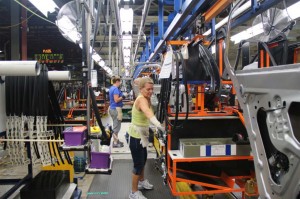What was once one of General Motors’ most promising assembly plants – only to face abandonment as the maker plunged into bankruptcy – is getting a new lease on life.
GM will nearly double the planned investment in its Spring Hill, Tennessee assembly plant, adding $167 million to a previous package of $183 million. That will bring two separate vehicle programs to the factory, originally put up as part of the once-promising Saturn project. In all, the total, $350 million in spending should create or retain about 1,800 jobs, according to the Detroit maker.
“Today’s announcement recognizes the commitment of Spring Hill employees and leadership,” said Mark Reuss, president, GM North America. “As a team, they draw upon the plant’s unique heritage and dedicated work force to deliver top quality for our customers.”
The Spring Hill plant was the resulted of a frenzied search touched off when GM announced plans to create its first all-new automotive brand in decades. The original plan was to create a high-tech facility that would produce low-cost, high-quality cars that could challenge the Japanese then gobbling up a growing share of the U.S. automotive market.
(Detroit automakers struggle to meet booming demand as U.S. auto market revives. Click Here for more.)
Tennessee won a bidding war among a number of states hoping to get the factory, offering GM an assortment of incentives that included training for new union workers who, in turn, agreed to a then groundbreaking contract that reduced restrictive job rules and lowered manufacturing costs.
The Spring Hill facility went into production in 1990 but was shuttered in 2007, seemingly for good, as GM started tumbling towards its Chapter 11 filing two years later. The once-vaunted Saturn brand was one of four GM marques – the others including Saab, Hummer and Pontiac – abandoned as the maker emerged from bankruptcy in July 2009.
Since then, GM has been rapidly investing in its U.S. plant network and the maker decided to bring Saturn back into the system, launching production of the Chevrolet Equinox crossover vehicle there during the third quarter of 2012.
The facility offers a number of advantages over older factories, including its ability to support a just-in-time production system where parts and components are delivered often just minutes before they’re needed on the line.
The new, $167 million investment will help support what GM only describes as a “future midsize vehicle program” that will generate 1,000 of the anticipated jobs.
A second program will also introduce a new midsize vehicle to the Spring Hill plant, creating or retaining another 800 jobs, according to GM.
“The hard work and dedication of our members once again proves that we can competitively manufacture vehicles for the future right here in Tennessee,” said United Auto Workers Union Vice President Joe Ashton, who directs the UAW’s GM Department.
The Spring Hill plant is today just one of an assortment of automotive manufacturing facilities in the mid-Southern state. Nissan recently completed a number of major expansion programs at its factory in Smyrna, adding a new line for the Leaf electric vehicle, with a separate operation dedicated to producing lithium-ion batteries. Volkswagen, meanwhile, is now looking at options to expand its own plant in Chattanooga, likely to produce a version of the Cross Blue crossover concept.


I love the way that GM feeds the public B.S…
The ONLY reason GM is investing in the Spring Hill facility is because it’s the cheapest means to increase production and sales which means larger annual compensation bonuses for the executive staff. We have seen GM’s moral compass many times. It knows no loyalty to employees, the U.S. or the tax payers who bailed it’s arse out of bankruptcy.
Jorge: Spoken like a true Socialist. Company’s exist to make money for the owners, not to employ people. Employees are expensive and can only be justified when they create value that overcomes their cost. GM was destroyed by greedy “workers” though I prefer “employees” and legacy benefit costs. They could not build a car that could compete price-wise, with the same features and still make money. So they shifted to Trucks which proved short sighted. Had the Gubment not interfered with the CH11 process Chrysler would not be owned by Fiat and GM would not have cost billions of taxpayer $$ to prop up the UAW.
To say Spring Hill is being used simply to pad the pockets of the Executives shows you know nothing about running a business. If Spring Hill is cheap well you can bet Mexico or Eastern Europe or China, Vietnam are even cheaper…. would you prefer GM take this work out of the US? Its a global economy dude to stay competitive you’ve got to lower your costs. Nissan, Toyota and Honda build cars here for economic reasons, perhaps the Japanese people should scream about the “greed” of those executives not the “health of their own company’s” I mean they ARE Japanese companies and profits do go to Japan. Maybe they should just keep production in Japan (for the workers) but then not be competitive, and thus go out of business? But oh…. hey, how many millions of US Citizens have jobs because of them? How about Mercedes & BMW & KIA & Hyundai.. keep your head in the sand, keep drinking the kook aide, ignorance is bliss I suppose.
Now tell me what Gm shares have to sell for the government to break even?